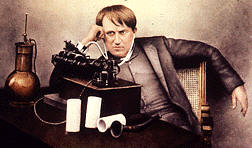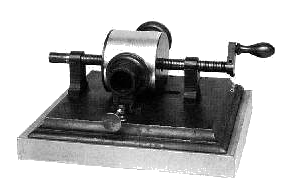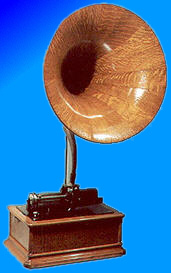The Phonograph...
|
The phonograph was the worlds first audio recording device. It was invented in 1877 by the American Thomas Edison (1847-1931). Early phonographs used a cylinder covered with strips of tinfoil wrapped around a 4" diameter drum. Recording and playback relied on acoustic means, a singer would sing into a horn attached to the phonograph. The audio vibrations would be transferred via a stylus assembly onto the tinfoil. This left a copy of the sound vibrations imprinted on the foil as the cylinder rotated and the stylus followed a spiral track. To playback the audio recording, a horn was attached to a second stylus assembly (at the rear of the phonograph). The drum was then rotated and the playback stylus would follow the spiral track and transfer the sound from the foil imprint to the horn for acoustic amplification. Rubber tubes could also be inserted into the ear to listen to the recording. This early design was refined over the next few years until 1888 when Edison perfected the phonograph to use wax cylinders 4"x21/4" in place of the fragile foil. The recording and playback time was around two minutes. The Phonograph eventually lost its popularity to the Gramophone (invented in 1888) that used flat discs. These could be mass produced easily from a "negative" disk press and were more convenient to store than the wax cylinder records. From around 1907 consumer
interest was shifting
away from the phonograph. The huge Columbia recording company also
stopped
all phonograph sales in 1907 to concentrate on the more popular
gramophone record. |
 Image:
Thomas Edison in 1888 Image:
Thomas Edison in 1888  Worlds first
audio recording machine - 1877 Listen to Edison talking in 1929 about
the first words recorded on his phonograph. Worlds first
audio recording machine - 1877 Listen to Edison talking in 1929 about
the first words recorded on his phonograph.Click here 
A 1911 Phonograph with a wooden horn |
